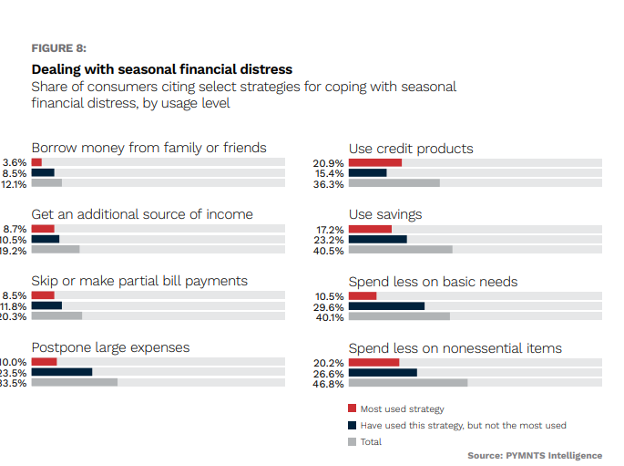
With October just about to dawn, many stores are already prodding consumers to think about the holiday shopping season, where December looms as a make-or-break month. The weeks leading into the end of the year are a marathon — and often a sprint — of frenzied spending.
But this time around, a strategic approach to get it all done seems warranted. Simply put, there’s not enough money in the till, so to speak, to flat-out splurge. Consumers may pursue a number of strategies to tick off the boxes, to make sure that everyone on the proverbial list is represented. That means using credit, of course — where that is possible.
Elsewhere, consumers may wind up trading down, or trading off, to ensure gift giving proceeds apace — call it, perhaps, a case of quantity outweighing quality.
PYMNTS research, spread across separate reports, underscores the pressures consumers are facing as they get ready for the holidays, and helps connect the dots as to how they might fill the online-and-in-store baskets.
As noted over the summer, 60% of consumers live paycheck to paycheck. That’s a population that includes 45% of high-income consumers. More than half of consumers who see their financial fortunes vary with the seasons have cited events and celebrations — i.e., the holidays themselves — as the reason for distress in the waning months of the year and into the new year.
And ’tis the season to use credit. The latest joint study by PYMNTS Intelligence and LendingClub reveals that 36% of consumers feeling seasonal stress are tapping the credit cards. The accompanying chart also details that 40% of consumers use savings, and to a lesser extent defer some larger purchases and 40% spend less on basic needs.

On that last point — and the fact that 20% skip or make partial bill payments — offer hints is that a significant strategy is one of self-denial (at least when it comes to buying items and services for personal use) and even flirting with negative impacts to one’s financial standing/credit scores.
If roughly half of consumers, as shown in the chart, spend less on nonessential items, and gifts are, essentially, nonessential, then the logic follows that consumers en masse will be looking for less expensive purchases to complete the holiday shopping journey.
Research from earlier in the year shows that the trade-down/trade-off practices are already firmly entrenched. As noted here, nearly 60% of consumers have cut spending on clothing and accessories, with 4 in 10 trading to less expensive brands. And within the retail segment, 60% of consumers have switched to cheaper retailers, while 35% have sacrificed product quality by switching to cheaper, lower-quality goods.
Needs must, as they say — and this time around, as interest rates continue to be stubbornly high, as credit card debt becomes ever more expensive, and student loan repayments kick back in, the trade-down strategy seems a viable one. It’s the thought that counts, though — isn’t it?
There are other areas in which consumers might pull back on spending, to keep at least some incremental dry spending power in hand — with some negative ripple effects in other corners of commerce. Spending for delivery of goods, especially groceries, may wane, and so might tipping. Consumers, after all, may find it easier to rein in spending on delivery fees, which can be significant, and rewarding strangers (through tipping on those services) in favor of diverting the funds to gifts for loved ones.